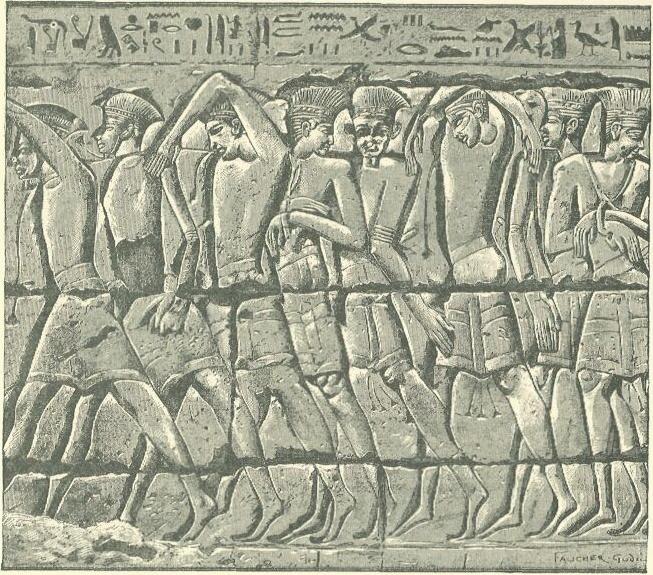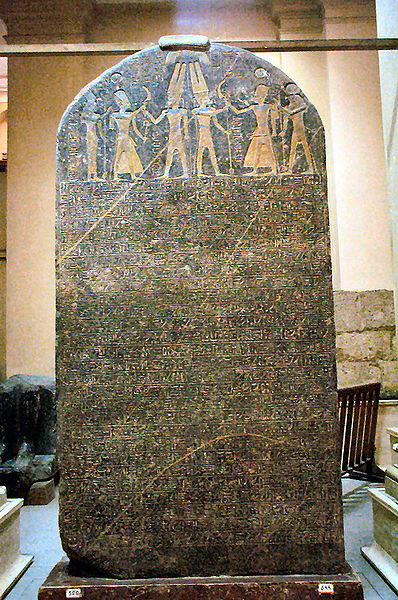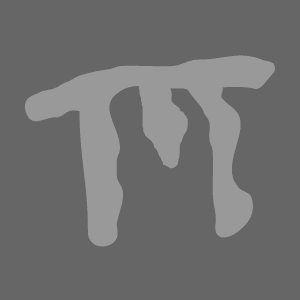|
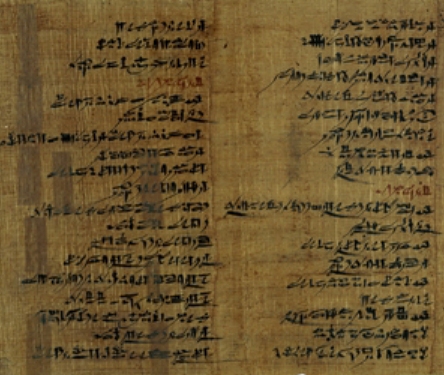
Instruction of Amenemope
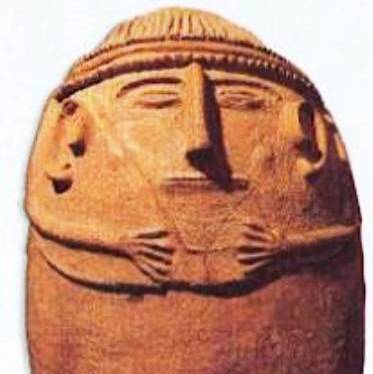
Philistine Canopus
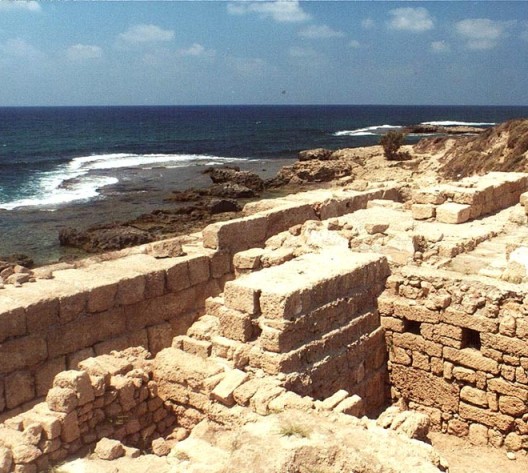
Ruins of Dor (Israel)
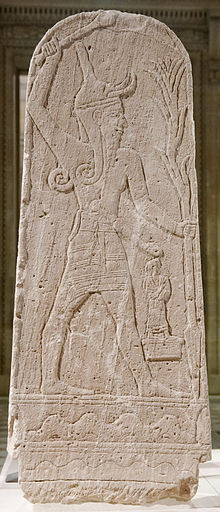
Ugaritic deity of lightning with
horned and stretched headdress
|
|
In
Papyrus Harris, Ramses III prides itself on being gone to fight Danaans in their islands (and this confirms their presence in
Cyprus), have taken prisoners Libyans and Shardanas and
destroyed Pelasgians and Teucers.
In fact, after the victories, in Djahy and Delta, Ramses should
have allowed his opponents to settle in the land of Canaan , as
vassals.
Two
papers, anyway, that attest the presence of the
Sea Peoples in Palestine, in the twelfth century, contradict the tone of
propaganda of Papyrus Harris .
In the
Egyptian work the "Istruction of Amenemope", written circa 1100
BC, there is a geographical description of the
towns of Syria and Palestine, with an indication of the people that live there.
The text mentions the city of Askhelon, Ashdod and Gaza, as the
seat of the Pelasgians and other locations further north, the name
of which - unfortunately - is incomplete, inhabited by Teucers and Shardanas, according to a geographical order.
Askhelon, Ashdod and Gaza are three cities that the Bible mentions as
inhabited by the Philistines.
Even on the basis of these indications , in fact, it is commonly
accepted that, after the defeat against the Egyptians of Ramses III, Pheleset would be stabilized in the land
still called Palestine, from their biblical
name of Philistines.
What
was the main city of the Teucers can be seen in another Egyptian
text, the novel "The Journey of Wenamun"
approx in 1080 BC.: in it the city of Dor, on the coast of Palestine, is
defined as "the city of Teucers".
The
Shardanas should therefore have established further north, roughly
in current Galilee. In the
the archaeological excavations in the region, we note that Mycenaean
III B
ceramic suddenly everywhere disappears, circa
1200.
In addition, on the levels that reveal a violent destruction,
it reappears next type Mycenaean III C 1 b ceramics (monochromatic
pottery 1175-1125).
This type of pottery, according to most archaeologists , is
due to the Sea Peoples.
The distribution of the population sees a large territory in southern
Palestine, since before Gaza until Tell Qasile, as well as Jaffa
and off until the early foothills of the interior, in the hands of the
Philistines, and to the north, an entity with the coastal port of
Dor and center Megiddo, within a radius of territory that
includes the foothills of Phoenicia, Galilee and other areas to the
south, inhabited by the Teucers, by Danaans and the Shardanas.
Missing, for the twelfth century, the archaeological evidence attesting the
presence of Sea Peoples in central Palestine and in the south-east hills, which are presumed to be inhabited by the Israelites.
The
Bible considers the area around Megiddo inhabited by Israelite tribes of Asher,
Issachar and Zebulun; beyond the Jordan, around the Golan Heights,
there was the territory of the tribe of Dan.
Etymological
correspondences and other passages of the Bible allow us to state that
these tribes were not composed by Israelite or Jewish populations but by Sea Peoples.
In particular, we can attribute the tribe of Dan to Danaans, the tribe of Issachar
to Teucers, and that of Zebulun to
Shardanas.
The tribe of Asher, still deriving from the Sea Peoples , was perhaps
composed of mixed population.
Dor was probably a "free port" or a common outlet to the sea.
Further
north, there were only ruins of Ugarit , while in Cilicia, on the
eastern shores of the ancient territory of Arzawa and the area around
Carchemish, had disappeared the use of cuneiform writing.
The
few documents that remain are written in hieroglyphic Luwian and in the language of Lukka.
For this reason, these Iron Age cultures were denominated "Neo-Luwians"
or "Eastern-Luwians" by
the archaeologist.
Anyway, they are composite cultures, resulting by a mixture of
populations, among which, in addition to Lukka, it could not miss the
descendants of Teresh, Shekelesh and other Shardanas.
One
part of these peoples, moreover, as a result of the upheavals occurred around 1200 BC, may have refugees in Cyprus, where
probably lived other Danaans, or in the Syrian coast, near the
ancient Ugarit destroyed by Shekelesh.
Most scholars believe
that Pheleset came from the island of Crete, called Keftiu by the
Egyptians. This would be deduced from the identification of the
toponym Keftiu with Bible Caphtor, the land of origin of the
Philistines, who - as we will see - would be no more than the
Pelasgians who settled in Palestine after the defeat of Djahy.
These populations, although not all originating from Greece, were
part of the Greek-Mycenaean Commonwealth, at least to share the type
of ceramics. This constitutes a consistent archaeological clue, to
identify the expansion of the sea Peoples in the Mediterranean
basin, in particular when the findings of the Mycenaean III C type
ceramics in particular when the latter, to neutron analysis, turns
out not to be imported but locally produced.
While Teucers and Danaans were certainly Greek language speakers,
it is not yet clear which language was spoken by Pelasgians at the
end of 13th century. B.C..
In Palestine, the appearance of
two-tone
type Mycenaean III
C
1 c
ceramic (1125
BC) shows the expansion
of the
Sea
Peoples,
but mainly
of the Philistines, on the
all land of Canaan.
The latter, in fact, seem
to have made vassal the Jewish tribes
and reunited
the north territories of the
Teucers due to the mastery of the technique
of smelting iron
to make more effective
weapons.
After some struggles,
moreover, seem to have assimilated or
made vassals
also their former
allies
(the
biblical Samson,
great opponent and a
prisoner of the
Philistine people came from the
tribe of Dan, and
therefore belonged
to the people of Danaans), although
now also
equipped with iron
weapons.
What had happened? To
understand this you need to
go back to investigate
the contemporary
situation of ancient Greece.
|
